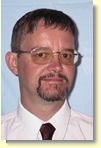|
. |
LAUDATION
 Professor Jeremy Hutson was born in 1957 in West Kirby in the UK. In 1979 he obtained the Bachelor degree from the University of Oxford, and in 1981 the Ph.D. degree in chemistry also from the University of Oxford. His Ph.D. work concerned theoretical studies of intermolecular interactions in small Van der Waals clusters by inversion of high-resolution spectroscopic data.
Professor Jeremy Hutson was born in 1957 in West Kirby in the UK. In 1979 he obtained the Bachelor degree from the University of Oxford, and in 1981 the Ph.D. degree in chemistry also from the University of Oxford. His Ph.D. work concerned theoretical studies of intermolecular interactions in small Van der Waals clusters by inversion of high-resolution spectroscopic data.
In 1981 Jeremy accepted a post-doctoral position at the University of Waterloo in Canada, where he worked in the group of Professor Robert J. Le Roy. In 1983 back in the UK, he spent 5 years at the University of Cambridge as a research fellow carrying out independent research in the Theoretical Chemistry Department. In 1987 he got a permanent position at the University of Durham, where he serves now as a full professor. At the age of 41 Jeremy became the Head of the Department of Chemistry at the University of Durham, and he served as the Head of the Department for three consecutive years.
Here in Warsaw we always thought that the name of Professor Kolos was associated with an unprecedented accuracy in the field of the electronic structure calculations. When I met Jeremy for the first time in 1993 in Nijmegen I quickly realized that Hutson is also a synonym for high accuracy, but in the field of intermolecular forces in Van der Waals molecules. As a matter of fact, Jeremy pioneered the use of the spectra of Van der Waals complexes and clusters to determine highly accurate potential energy surfaces for atomic and molecular interactions. His seminal work on intermolecular forces in small Van der Waals complexes such as ArHF, ArHCl, and other produced intermolecular potentials of unprecedented accuracy. For us, people working in ab initio calculations of intermolecular forces, the results obtained by Jeremy always served as the highest quality standards.
Jeremy Hutson made several remarkable contributions to the field of chemical dynamics of Van der Waals complexes. Here his scientific achievements are too numerous to discuss in details. Let me mention that Jeremy was the pioneer in the field of Van der Waals molecules in the pre-reactive entrance channels of chemical reactions. I can hardly remember any paper published by the Warsaw Quantum Chemistry Laboratory that would not refer to these seminal papers of Jeremy. He is the author of the MOLSCAT program, which is a widely distributed package for quantum dynamics calculations of molecular inelastic collisions, and BOUND, for calculations on the ro-vibrational states of weakly bound molecules and clusters. Both packages are widely used by experimental and theoretical groups throughout the world, not only in the field of molecular physics, but also in astrophysics and other domains of science.
In the new millennium Jeremy moved his scientific interests to the ultra-cold molecules, a new emerging field at the border of physics and chemistry. He performed the first quantum dynamics calculations on alkali metal atom + diatom collisions, including the reactive channel. He also carried out the first calculations of barrierless atom exchange reactions in which the reactants and products are distinguishable. Finally, he reported the first estimations of the cross sections for elastic and inelastic collisions between polar molecules and alkali atoms, the data of crucial importance for the ongoing experiments on the sympathetic cooling of molecules.
I had the privilege to work with Jeremy Hutson on one paper concerning differential scattering cross sections for collisions of argon atoms with methane. I could appreciate his very deep understanding of the problem, his ability to explain patiently some of my (naive) questions. I could also see that he never compromises on the quality of his scientific work, insisting that it should always be measured by the highest standards.
|
|
.
|
|
. | | |



